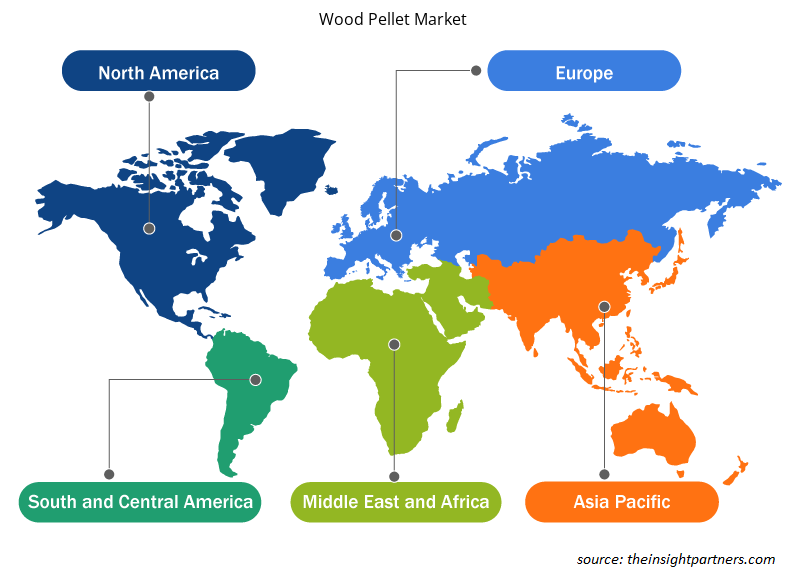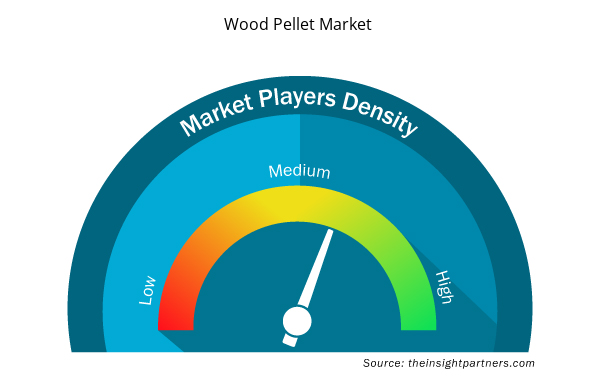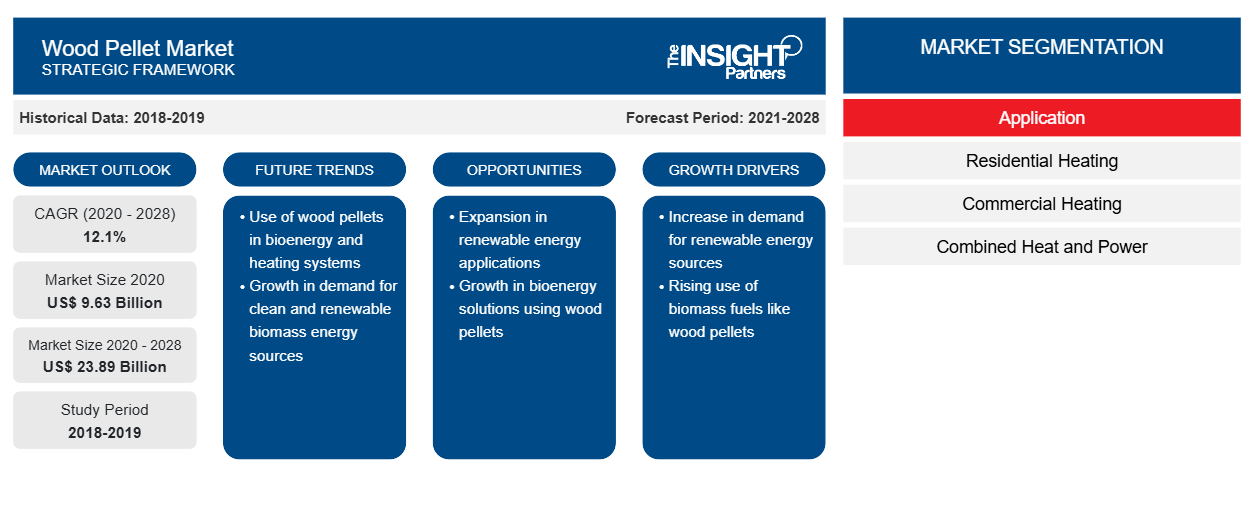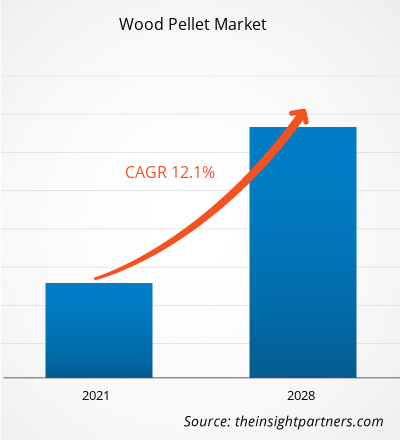Nel 2020 il mercato dei pellet di legno era valutato 9.630,99 milioni di dollari USA e si prevede che raggiungerà i 23.892,77 milioni di dollari USA entro il 2028; si prevede una crescita a un CAGR del 12,1% dal 2021 al 2028.
I pellet di legno sono prodotti utilizzando corteccia di legno finemente macinata; sono usati principalmente come combustibile. Sono ampiamente usati nelle case residenziali per una combustione efficiente in stufe più piccole. I pellet di legno sono prodotti da numerosi scarti di legno e sono considerati una fonte di energia rinnovabile. Attualmente, insieme al riscaldamento residenziale, c'è un uso crescente di pellet di legno per la produzione di energia in tutto il mondo. Questi sono ampiamente utilizzati a livello globale come combustibile, il che dovrebbe aumentare la domanda di pellet di legno nei prossimi anni. L'Europa è la regione leader per il consumo di pellet di legno per la produzione di energia. Inoltre, il Nord America è il principale esportatore di pellet di legno, il che dovrebbe aumentare le strutture di produzione di pellet di legno nei prossimi anni.
Nel 2020, l'Europa ha contribuito alla quota maggiore del mercato globale. Un rapporto annuale depositato presso il Global Agriculture Information Network dell'USDA Foreign Agricultural Service afferma che il mercato dei pellet di legno in Europa è stato relativamente poco influenzato dalla pandemia di COVID-19. Secondo il rapporto, la regione ha consumato circa 29 milioni di tonnellate di pellet di legno nel 2018, il che la rende il più grande mercato di pellet al mondo. I pellet di legno sono utilizzati in applicazioni residenziali per scopi di riscaldamento e per la generazione di calore ed energia industriale. Il rapporto afferma inoltre che la regione contribuisce attualmente a circa il 30% della produzione mondiale di pellet. Tuttavia, rappresenta il principale consumo di pellet di legno in tutto il mondo. Italia, Germania e altri paesi simili sono considerati i principali mercati in crescita per il consumo di pellet di legno nelle applicazioni di riscaldamento residenziale. Il Regno Unito è uno dei principali consumatori di pellet di legno, seguito da Italia e Danimarca.
Il mercato globale dei pellet di legno ha dovuto affrontare molte sfide a causa dell'impatto dell'epidemia di COVID-19. L'attuale pandemia di COVID-19 ha alterato drasticamente lo stato del settore chimico e dei materiali e ha avuto un impatto negativo sulla crescita del mercato dei pellet di legno. L'attuazione di misure per combattere la diffusione del virus ha aggravato la situazione e ha influenzato la crescita di diversi settori industriali. Il mercato è stato influenzato dall'improvvisa distorsione delle efficienze operative e dalle interruzioni nelle catene del valore attribuibili alla chiusura improvvisa dei confini nazionali e internazionali. Le interruzioni in termini di approvvigionamento di materie prime dai fornitori e le chiusure temporanee delle basi di produzione dovute a blocchi indefiniti e quarantene temporanee hanno avuto un impatto sulla crescita del mercato durante la pandemia. Secondo una notizia pubblicata da Woodcote Media Ltd il 30 luglio 2020, un sondaggio condotto da ENplus, uno schema di certificazione per i pellet di legno, ha affermato che il 75% dei produttori certificati è stato influenzato negativamente dalla pandemia di COVID-19. Le aziende stanno pianificando di rivedere i prezzi dei pellet di legno per gli utenti finali. Tuttavia, lo stesso rapporto ha rappresentato che circa il 5% degli intervistati ritiene che vi sia un leggero aumento della domanda di pellet di legno da parte degli utenti finali. Allo stesso modo, la filiera del legno è stata colpita dalla pandemia, che ha causato interruzioni nella fornitura e nei prezzi delle materie prime.
Personalizza questo report in base alle tue esigenze
Riceverai la personalizzazione gratuita di qualsiasi report, comprese parti di questo report, o analisi a livello nazionale, pacchetto dati Excel, oltre a usufruire di grandi offerte e sconti per start-up e università
- Scopri le principali tendenze di mercato in questo rapporto.Questo campione GRATUITO includerà analisi di dati che spaziano dalle tendenze di mercato alle stime e alle previsioni.
Approfondimenti di mercato
Crescente consapevolezza sull'uso di fonti energetiche rinnovabili
L'energia rinnovabile svolge un ruolo fondamentale nel soddisfare le future esigenze energetiche sia nelle aree rurali che urbane. La scarsità di risorse, insieme a una maggiore consapevolezza degli impatti ambientali negativi dei prodotti e dei processi basati sui combustibili fossili, ha fatto aumentare la dipendenza da fonti di energia rinnovabile come i pellet di legno. La crescente necessità di uno sviluppo energetico sostenibile è un altro fattore che contribuisce all'aumento della domanda di pellet di legno. Le risorse e le tecnologie di energia rinnovabile sono considerate alternative ecocompatibili in quanto generalmente causano un impatto limitato o nullo sull'ambiente rispetto ad altre forme di fonti energetiche. Inoltre, tali risorse sono facilmente disponibili e non possono essere esaurite.
I pellet di legno sono classificati tra le fonti di energia rinnovabili in quanto sono derivati dagli alberi e sono una forma di biomassa. I pellet di legno sono composti da fibre di legno essiccate e compresse preparate da residui di segheria, detriti di disboscamento come cumuli di detriti forestali e tronchi interi. Secondo la US Energy Information Administration, la biomassa è classificata come un materiale organico che può essere utilizzato efficacemente come fonte di energia. Diverse forme di biomassa come i pellet di legno sono carbon neutral e lasciano un'impronta di carbonio netta pari a zero quando si brucia la biomassa.
Tipo Informazioni
In base all'applicazione, il mercato globale dei pellet di legno è segmentato in riscaldamento residenziale, riscaldamento commerciale, CHP (cogenerazione di calore ed energia) e generazione di energia. Il segmento del riscaldamento residenziale ha guidato il mercato globale dei pellet di legno nel 2020. I sistemi alimentati a legna sono comunemente utilizzati in tutto il mondo per il riscaldamento residenziale e di recente i pellet di legno hanno sostituito la tradizionale legna da ardere. Le caldaie a pellet di legno per applicazioni di riscaldamento residenziale promettono basse emissioni, elevata efficienza e funzionamento automatico. I pellet di legno sono utilizzati per il riscaldamento residenziale nelle stufe a pellet. Sono inoltre utilizzati nelle caldaie a pellet per generare calore, vapore ed elettricità nel settore dei servizi, nella generazione di energia e nella produzione. Sono utilizzati per la generazione di energia e calore nei settori manifatturiero ed energetico, che sta guidando il mercato dei pellet di legno. Poiché il costo dei pellet di legno è rimasto più economico di quello di altri combustibili per lungo tempo, diventa un'opzione più economica, affrontando la preoccupazione principale del settore residenziale. Come fonte di energia rinnovabile, i pellet di legno hanno ricevuto incentivi e sussidi dai governi di diversi paesi. Negli ultimi anni molti Paesi hanno lanciato o aggiornato le proprie politiche e i propri programmi relativi all'uso del pellet di legno per il riscaldamento.
Tra i principali attori del mercato dei pellet di legno figurano Pacific BioEnergy, Premium Pellet Ltd., Pinnacle Renewable Energy, Enviva, ANDRITZ, Wood & Sons, Graanul Invest, New England Wood Pellet, TANAC ed Energex Pellet Fuel, Inc.
Segnala i riflettori
- Tendenze industriali progressive nel mercato globale dei pellet di legno per aiutare gli operatori a sviluppare strategie efficaci a lungo termine
- Strategie di crescita aziendale adottate dai mercati sviluppati e in via di sviluppo
- Analisi quantitativa del mercato globale dei pellet di legno dal 2019 al 2028
- Stima della domanda di mercato del pellet di legno in vari settori
- Analisi PEST per illustrare l'efficacia degli acquirenti e dei fornitori che operano nel settore per prevedere la crescita del mercato
- Sviluppi recenti per comprendere lo scenario competitivo del mercato e la domanda di pellet di legno
- Tendenze e prospettive del mercato, insieme ai fattori che guidano e frenano la crescita del mercato dei pellet di legno
- Processo decisionale attraverso la comprensione delle strategie che sostengono l'interesse commerciale in relazione alla crescita del mercato globale dei pellet di legno
- Dimensioni del mercato dei pellet di legno nei vari nodi del mercato
- Panoramica dettagliata e segmentazione del mercato globale dei pellet di legno, nonché delle sue dinamiche nel settore
- Dimensioni del mercato dei pellet di legno in varie regioni con promettenti opportunità di crescita
Approfondimenti regionali sul mercato dei pellet di legno
Le tendenze regionali e i fattori che influenzano il mercato dei pellet di legno durante il periodo di previsione sono stati ampiamente spiegati dagli analisti di Insight Partners. Questa sezione discute anche i segmenti e la geografia del mercato dei pellet di legno in Nord America, Europa, Asia Pacifico, Medio Oriente e Africa e America centrale e meridionale.

- Ottieni i dati specifici regionali per il mercato dei pellet di legno
Ambito del rapporto sul mercato dei pellet di legno
| Attributo del report | Dettagli |
|---|---|
| Dimensioni del mercato nel 2020 | 9,63 miliardi di dollari USA |
| Dimensioni del mercato entro il 2028 | 23,89 miliardi di dollari USA |
| CAGR globale (2020 - 2028) | 12,1% |
| Dati storici | 2018-2019 |
| Periodo di previsione | 2021-2028 |
| Segmenti coperti | Per applicazione
|
| Regioni e Paesi coperti | America del Nord
|
| Leader di mercato e profili aziendali chiave |
|
Densità degli attori del mercato dei pellet di legno: comprendere il suo impatto sulle dinamiche aziendali
Il mercato del pellet di legno sta crescendo rapidamente, spinto dalla crescente domanda degli utenti finali dovuta a fattori quali l'evoluzione delle preferenze dei consumatori, i progressi tecnologici e una maggiore consapevolezza dei benefici del prodotto. Con l'aumento della domanda, le aziende stanno ampliando le loro offerte, innovando per soddisfare le esigenze dei consumatori e capitalizzando sulle tendenze emergenti, il che alimenta ulteriormente la crescita del mercato.
La densità degli operatori di mercato si riferisce alla distribuzione di aziende o società che operano in un particolare mercato o settore. Indica quanti concorrenti (operatori di mercato) sono presenti in un dato spazio di mercato in relazione alle sue dimensioni o al valore di mercato totale.
Le principali aziende che operano nel mercato dei pellet di legno sono:
- Bioenergia del Pacifico
- Pellet Premium Ltd.
- Pinnacle Energia Rinnovabile
- Enviva
- ANDRITZ
Disclaimer : le aziende elencate sopra non sono classificate secondo un ordine particolare.

- Ottieni una panoramica dei principali attori del mercato dei pellet di legno
Il rapporto segmenta il mercato globale dei pellet di legno come segue:
Mercato dei pellet di legno, per applicazione
- In base all'applicazione, il mercato globale dei pellet di legno è segmentato in riscaldamento residenziale, riscaldamento commerciale, cogenerazione (CHP) e produzione di energia.
Profili aziendali
- Bioenergia del Pacifico
- Pellet Premium Ltd.
- Pinnacle Energia Rinnovabile
- Enviva
- ANDRITZ
- Legno e figli
- Investimento Graanul
- Pellet di legno New Englandtv5/8520
- TANAC
- Energex Pellet Fuel, Inc.
- Analisi storica (2 anni), anno base, previsione (7 anni) con CAGR
- Analisi PEST e SWOT
- Valore/volume delle dimensioni del mercato - Globale, regionale, nazionale
- Industria e panorama competitivo
- Set di dati Excel


- Mice Model Market
- Digital Language Learning Market
- Identity Verification Market
- Oxy-fuel Combustion Technology Market
- Non-Emergency Medical Transportation Market
- Cosmetic Bioactive Ingredients Market
- Vertical Farming Crops Market
- Bio-Based Ethylene Market
- Investor ESG Software Market
- Electronic Health Record Market

Report Coverage
Revenue forecast, Company Analysis, Industry landscape, Growth factors, and Trends

Segment Covered
This text is related
to segments covered.

Regional Scope
North America, Europe, Asia Pacific, Middle East & Africa, South & Central America

Country Scope
This text is related
to country scope.
Domande frequenti
Asia Pacific is estimated to register the fastest CAGR in the market over the forecast period. Rising industrialization and urbanization in these countries offer ample opportunities for the key market players. The wood pellet industry in APAC countries has experienced a considerable shift over the years. The massive market growth in the region is attributed to the rising investments in sustainable and bio-based solutions in economies, such as India and China. Furthermore, favorable government policies attract new and international players to set their wood pellet manufacturing plants across China, India, and Japan.
Wood-fuelled systems are commonly used worldwide for residential heating, and recently wood pellets have been replacing traditional firewood. Wood pellet boilers for residential heating applications promise low emissions, high efficiency, and automatic operation. Wood pellets are used for residential heating in pellet stoves and pellet boilers to generate heat, steam, and electricity in the service industry, power generation, and manufacturing. It is used for power generation and heat generation in the manufacturing and energy sectors, which is driving the wood pellet market. Since the cost of wood pellets remained cheaper than that of other fuels for a long time, it becomes a more economical option, addressing the primary concern of the residential sectors. As a renewable energy source, wood pellets had received incentives and subsidies from the governments in many countries.
The major players operating in the wood pellet market are ANDRITZ, Energex Pellet Fuel, Inc., Enviva, New England Wood Pellet LLC, Pacific BioEnergy, Pinnacle Renewable Energy Inc, Premium Pellet Ltd., Graanul Invest, Wood & Sons, and TANAC.
In 2021, Europe held the largest revenue share of the global wood pellet market. An annual report filed with the USDA Foreign Agricultural Service’s Global Agriculture Information Network represents that the wood pellet market in Europe has been relatively unaffected by the COVID-19 pandemic. As per the report, the region consumed ~29 million metric tons of wood pellets in 2018, which makes it the world’s largest pellet market. Wood pellets are used in residential applications for heating purposes and industrial heat and power generation. The report further states that the region contributes ~30% of world pellet production currently. However, it accounts for the major consumption of wood pellets across the globe. Italy, Germany, and other such countries are considered as the major growth markets for consuming wood pellets in residential heating applications. The UK is one of the major consumers of wood pellets, followed by Italy and Denmark.
Trends and growth analysis reports related to Chemicals and Materials : READ MORE..
The List of Companies - Wood Pellet Market
- Pacific BioEnergy
- Premium Pellet Ltd.
- Pinnacle Renewable Energy
- Enviva
- ANDRITZ
- Wood & Sons
- Graanul Invest
- New England Wood Pellet
- TANAC
- Energex Pellet Fuel, Inc.
The Insight Partners performs research in 4 major stages: Data Collection & Secondary Research, Primary Research, Data Analysis and Data Triangulation & Final Review.
- Data Collection and Secondary Research:
As a market research and consulting firm operating from a decade, we have published and advised several client across the globe. First step for any study will start with an assessment of currently available data and insights from existing reports. Further, historical and current market information is collected from Investor Presentations, Annual Reports, SEC Filings, etc., and other information related to company’s performance and market positioning are gathered from Paid Databases (Factiva, Hoovers, and Reuters) and various other publications available in public domain.
Several associations trade associates, technical forums, institutes, societies and organization are accessed to gain technical as well as market related insights through their publications such as research papers, blogs and press releases related to the studies are referred to get cues about the market. Further, white papers, journals, magazines, and other news articles published in last 3 years are scrutinized and analyzed to understand the current market trends.
- Primary Research:
The primarily interview analysis comprise of data obtained from industry participants interview and answers to survey questions gathered by in-house primary team.
For primary research, interviews are conducted with industry experts/CEOs/Marketing Managers/VPs/Subject Matter Experts from both demand and supply side to get a 360-degree view of the market. The primary team conducts several interviews based on the complexity of the markets to understand the various market trends and dynamics which makes research more credible and precise.
A typical research interview fulfils the following functions:
- Provides first-hand information on the market size, market trends, growth trends, competitive landscape, and outlook
- Validates and strengthens in-house secondary research findings
- Develops the analysis team’s expertise and market understanding
Primary research involves email interactions and telephone interviews for each market, category, segment, and sub-segment across geographies. The participants who typically take part in such a process include, but are not limited to:
- Industry participants: VPs, business development managers, market intelligence managers and national sales managers
- Outside experts: Valuation experts, research analysts and key opinion leaders specializing in the electronics and semiconductor industry.
Below is the breakup of our primary respondents by company, designation, and region:

Once we receive the confirmation from primary research sources or primary respondents, we finalize the base year market estimation and forecast the data as per the macroeconomic and microeconomic factors assessed during data collection.
- Data Analysis:
Once data is validated through both secondary as well as primary respondents, we finalize the market estimations by hypothesis formulation and factor analysis at regional and country level.
- Macro-Economic Factor Analysis:
We analyse macroeconomic indicators such the gross domestic product (GDP), increase in the demand for goods and services across industries, technological advancement, regional economic growth, governmental policies, the influence of COVID-19, PEST analysis, and other aspects. This analysis aids in setting benchmarks for various nations/regions and approximating market splits. Additionally, the general trend of the aforementioned components aid in determining the market's development possibilities.
- Country Level Data:
Various factors that are especially aligned to the country are taken into account to determine the market size for a certain area and country, including the presence of vendors, such as headquarters and offices, the country's GDP, demand patterns, and industry growth. To comprehend the market dynamics for the nation, a number of growth variables, inhibitors, application areas, and current market trends are researched. The aforementioned elements aid in determining the country's overall market's growth potential.
- Company Profile:
The “Table of Contents” is formulated by listing and analyzing more than 25 - 30 companies operating in the market ecosystem across geographies. However, we profile only 10 companies as a standard practice in our syndicate reports. These 10 companies comprise leading, emerging, and regional players. Nonetheless, our analysis is not restricted to the 10 listed companies, we also analyze other companies present in the market to develop a holistic view and understand the prevailing trends. The “Company Profiles” section in the report covers key facts, business description, products & services, financial information, SWOT analysis, and key developments. The financial information presented is extracted from the annual reports and official documents of the publicly listed companies. Upon collecting the information for the sections of respective companies, we verify them via various primary sources and then compile the data in respective company profiles. The company level information helps us in deriving the base number as well as in forecasting the market size.
- Developing Base Number:
Aggregation of sales statistics (2020-2022) and macro-economic factor, and other secondary and primary research insights are utilized to arrive at base number and related market shares for 2022. The data gaps are identified in this step and relevant market data is analyzed, collected from paid primary interviews or databases. On finalizing the base year market size, forecasts are developed on the basis of macro-economic, industry and market growth factors and company level analysis.
- Data Triangulation and Final Review:
The market findings and base year market size calculations are validated from supply as well as demand side. Demand side validations are based on macro-economic factor analysis and benchmarks for respective regions and countries. In case of supply side validations, revenues of major companies are estimated (in case not available) based on industry benchmark, approximate number of employees, product portfolio, and primary interviews revenues are gathered. Further revenue from target product/service segment is assessed to avoid overshooting of market statistics. In case of heavy deviations between supply and demand side values, all thes steps are repeated to achieve synchronization.
We follow an iterative model, wherein we share our research findings with Subject Matter Experts (SME’s) and Key Opinion Leaders (KOLs) until consensus view of the market is not formulated – this model negates any drastic deviation in the opinions of experts. Only validated and universally acceptable research findings are quoted in our reports.
We have important check points that we use to validate our research findings – which we call – data triangulation, where we validate the information, we generate from secondary sources with primary interviews and then we re-validate with our internal data bases and Subject matter experts. This comprehensive model enables us to deliver high quality, reliable data in shortest possible time.


 Ottieni un campione gratuito per questo repot
Ottieni un campione gratuito per questo repot